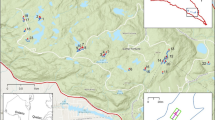Abstract
Nineteen mature Atlantic white-cedar swamps, located in four categories of undeveloped and suburban watersheds of the New Jersey Pinelands, were studied to determine the relationship between perturbations of water quality and hydrology and changes in species composition and community structure. Rank-orders of the 19 sites were compared for key variables (ground-water and surface-water NH4 and PO4, mean water-table level and water-table range). Rank orders for the sites were different for the various parameters, suggesting little congruence among water quality and hydrologic changes at wetlands within urban basins. Changes in species composition, measured as the number of invading species, were correlated with the number of perturbed chemical and hydrologic parameters and were not related to the absolute magnitude of any one parameter. Sites in developed watersheds supported a larger fraction of facultative upland and upland species than did sites in undisturbed watersheds; this change could affect wetland delineation of urban wetlands. Urbanization thus increases variability in environmental quality among sites of a given type of wetland and fosters an increase in proportion of non-hydrophytic vegetation within such wetlands.
Similar content being viewed by others
Literature cited
Anon. 1989. Federal Manual for Identifying and Delineating Jurisdictional Wetlands. Cooperative technical publication of U.S. Army Corps of Engineers, U.S. Environmental Protection Agency, U.S. Fish and Wildlife Service, and U.S.D.A. Soil Conservation Service, Washington, DC, USA.
American Public Health Association. 1981. Standard Methods for the Examination of Water and Wastewater, 15th edition. American Public Health Association, Washington, DC, USA.
Browne, F. X., J. B. Orr, T. J. Grizzard, and B. L. Weand. 1982. Non-point sources. Journal of the Water Pollution Control Federation 54:755–563.
Bryan, E. H. 1970. Quality of stormwater drainage from urban land areas in North Carolina. Water Resources Research Institute of University of North Carolina Report No. 37. Chapel Hill, NC, USA.
Dahl, T. E., C. E. Johnson, and W. E. Frayer. 1991. Wetlands: Status and trends in the conterminous United States, mid 1970’s to mid 1980’s. U.S. Department of the Interior, Fish and Wildlife Servive, Washington, DC, USA.
Durand, J. and B. Zimmer. 1982. Pinelands Surface-water Quality. Part 1. Final Report. Center for Coastal and Environmental Studies, Rutgers University, New Brunswick, NJ, USA.
Ehrenfeld, J.G. and M.K. Gulick. 1981. Structure and dynamics of hardwood swamps in the New Jersey Pine Barrens: contrasting patterns in trees and shrubs. American Journal of Botany 68:500–512.
Ehrenfeld, J.G. and J.P. Schneider. 1990. The response of Atlantic white cedar wetlands to varying levels of disturbance from suburban development in the New Jersey Pinelands. p. 63–78.In J. Kvet, D. Whigham, and R. Good (eds.) Management of Wetlands, Tasks for Vegetation Science 25. Kluwer Academic Publishers, Dordrecht, The Netherlands.
Ehrenfeld, J.G. and J.P. Schneider. 1991.Chamaecyparis thyoides wetlands and suburbanization: effects of nonpoint source water pollution on hydrology and plant community structure. Journal of Applied Ecology 28:467–490.
Good, R. E. and N. F. Good. 1984. The Pinelands National Reserve: an ecosystem approach to management. BioScience 34:169–173.
Hoffman, E., J. S. Latimer, C. D. Hunt, G. L. Mills, and J. G. Quinn. 1985. Stormwater runoff from highways. Water, Air and Soil Pollution 25:349–364.
Laderman, A. 1989. The Ecology of Atlantic White Cedar Wetlands: A Community Profile. U.S. Fish and Wildlife Service, Washington, DC, USA. Biological Report 85(7.21).
Means, J. L., R. F. Yuretich, D. A. Crerar, D. J. Kinsman, and M. P. Borcsik. 1981. Hydrogeochemistry of the New Jersey Pine Barrens. New Jersey Geological Survey, Bulletin No. 76, Trenton, NJ, USA.
Moore, P. D. and S. B. Chapman (eds). 1986. Methods in Plant Ecology, 2nd ed. Blackwell Scientific Publications, New York, NY, USA.
Patterson, C. S. and I. A. Mendelssohn. 1991. A comparison of physicochemical variables across plant zones in a mangal/salt marsh community in Louisiana. Wetlands 11:139–162.
Pye, V. I., R. Patrick, and J. Quarles. 1983. Ground-water Contamination in the United States. University of Pennsylvania Press, Philadelphia, PA, USA.
Reed, P. B., Jr. 1988. National List of Plant Species that Occur in Wetlands: Northeast (Region I). U.S. Fish and Wildlife Service, Washington, DC, USA. Biological Report 88(26.1).
Rheinhardt, R. 1992. A multivariate analysis of vegetation patterns in tidal freshwater swamps of lower Chesapeake Bay, U.S.A. Bulletin of the Torrey Botanical Club 119:192–207.
Rhodehamel, E. C. 1970. A hydrological analysis of the Pine Barrens region. New Jersey Water Policy Board Circular No. 22. Trenton, NJ, USA.
Rhodehamel, E. C. 1979. Hydrology of the New Jersey Pine Barrens. p. 147–168.In R. T. T. Forman (ed.) Pine Barrens: Ecosystem and Landscape. Academic Press, New York, NY, USA.
Schneider, J. 1988. The effects of suburban development on the hydrology, water quality and community structure ofChamaecyparis thyoides (L.) B.S.P. wetlands in the New Jersey Pinelands. Ph.D. Dissertation, Rutgers University, New Brunswick, NJ, USA.
Snyder, D. B. and V. E. Vivian. 1981. Rare and endangered vascular plant species in New Jersey. Conservation and Environmental Studies Center, Glassboro, NJ, USA.
Solorzano, L. 1969. Determination of ammonia in natural waters by the phenolhypochlorite method. Limnology and Oceanography 14:789–801.
Stone, W. 1911. The plants of southern New Jersey with especial reference to the flora of the Pine Barrens and the geographic distribution of the species. Annual report of the New Jersey State Museum, Trenton, NJ, USA.
Tiner, R. W., Jr. 1985. Wetlands of New Jersey. U.S. Fish and Wildlife Service, National Wetlands Inventory, Newton Corner, MA, USA.
Vitt, D. H. and S. Bayley. 1984. The vegetation and water chemistry of four oligotrophic basin mires in northwestern Ontario. Canadian Journal of Botany 62:1485–1500.
Zampella, R. A. 1990. Gradient analysis and classification of pitch pine (Pinus rigida Mill.) lowland communities in the New Jersey Pinelands. Ph.D. Dissertation, Rutgers University, New Brunswick, NJ, USA.
Author information
Authors and Affiliations
Rights and permissions
About this article
Cite this article
Ehrenfeld, J.G., Schneider, J.P. Responses of forested wetland vegetation to perturbations of water chemistry and hydrology. Wetlands 13, 122–129 (1993). https://doi.org/10.1007/BF03160872
Received:
Revised:
Accepted:
Issue Date:
DOI: https://doi.org/10.1007/BF03160872




